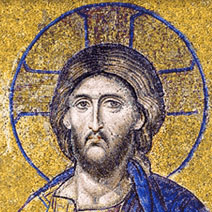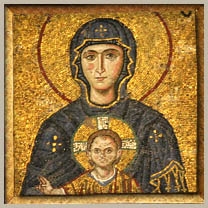It really is a miracle that this mosaic survived the abuse of centuries. Here you can learn how the Byzantine Institute of America found the mosaics, uncovered and restored them for us to see today.

|


The Library of the Empress Maria Feodorovna is laid out on the same plan as the Tapestry Room. Its rounded wall is adorned with a large Gobelins tapestry Don Quixote Consults the Enchanted Head, one of the-Don Quixote series done by Pierre-Francois Cozette in 1780. The side walls are hung with two Gobelins tapestries woven in the 1770s to the designs of Claude Audran III: Jupiter Representing the Element Fire, and Ceres Symbolizing the Season Summer, from the Curtains of the Gods series, consisting of eight tapestries with allegories of the seasons and the elements. All these tapestries have retained their original brilliance of colour, and this gives them additional charm.
Here, in the Library of the Empress, Just as in that of Paul I, the low book cabinets serve as bases for numerous sculptures. Intended for formal receptions, the room was calculated to impress the visitor with the idea that its mistress patronized art in all its forms. The marble figures of Apollo Citharaedus and The Nine Muses on the book cabinets lining the walls, copies of genuine antiquities preserved in the Vatican, were made by Italian sculptors. The Sleeping Ariadne is also a copy of a Vatican original. An exception is Polyhymnia, an antique Roman sculpture which dates back to the second century AD. The writing table, created in 1784 by David Roentgen, is remarkable for the skillful use of mahogany of different shades and patterns of graining, for its excellent polish and the fine ormolu and brass decorations which serve to bring out the contours. The armchair at the table, painted in imitation of antique bronze, was designed by Voronikhin. The cornucopias flanking the back were made hollow in the upper part, so as to hold flower-pots: flowers were in great favour in the early nineteenth century. Well in keeping with the architecture and furnishings of the Library is the chandelier of almond-shaped crystal drops. This chandelier, in the form of a bowl, and its twin in the Tapestry Room, were made in 1804 from the sketches of Voronikhin. The ormolu framework for chandeliers was generally made in the numerous bronzesmiths shops of 5t Petersburg, and the glass and crystal details at the 5t Petersburg Imperial Glass House. The cutting of crystal was done at the Peterhof Factory. The wonderful chandeliers sparkling with all the colours of the rainbow that adorn the halls of the Pavlovsk Palace are the work of 5t Petersburg craftsmen. In 1967, when the palace was undergoing reconstruction, the inlaid floors of the Library and the adjoining three rooms of the southern suite, ruined by the fire of 1803 and left unrestored, were finally reproduced after fragments preserved from the eighteenth century. These superb, finely designed floors are made of amaranth, rosewood, sandalwood, palm wood and mahogany.    |

|





